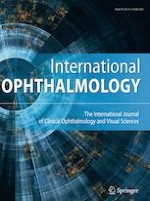Erschienen in:

27.01.2022 | Original Paper
Newly developed abnormal head position and secondary esotropia after strabismus surgery for children with intermittent exotropia
verfasst von:
Tao Shen, Ying Kang, Xiaoming Lin, Heping Wu, Jianhua Yan
Erschienen in:
International Ophthalmology
|
Ausgabe 10/2022
Einloggen, um Zugang zu erhalten
Abstract
Purpose
To review cases of newly developed AHP and secondary esotropia (ET) after surgical correction for IXT.
Methods
Medical records of cases with newly developed AHP and secondary ET after surgical correction for IXT were retrospectively reviewed.
Results
Fifteen cases were included and the mean pre-operative exodeviation was 31.7 ± 10.6 prism diopters (PD) (range: 16–50) at distance. They received bilateral lateral rectus (LR) recessions (13/15), unilateral LR recession and medial rectus (MR) resection (1/15) or bilateral LR recession plus unilateral MR resection (1/15). Fourteen patients developed chin-down AHP with secondary V-pattern ET and 1 presented chin-up AHP with secondary A-pattern ET. The mean esodeviation in primary gaze was 22.7 ± 10.0 PD (range: 3–40) at distance. Twelve cases underwent a second surgery for correction of AHP and secondary ET, and approximately half (5/11) of the recessed LR muscles explored showed a 3–5 mm downward displacement of the new attachment. Surgical management mainly included advancement of LR to the original insertion with a 3–5 mm upward transposition. The AHP dissipated and ocular alignment returned to normal in all of these cases. Three cases did not require further surgery, and their AHP and secondary ET were no longer present at 2–5 months after the first surgery.
Conclusion
A downward shift of the recessed LR in IXT may lead to secondary V-pattern ET and development of a chin-down AHP. Advancement of LR with an upward transposition serves as an effective procedure for the correction of this complication.











